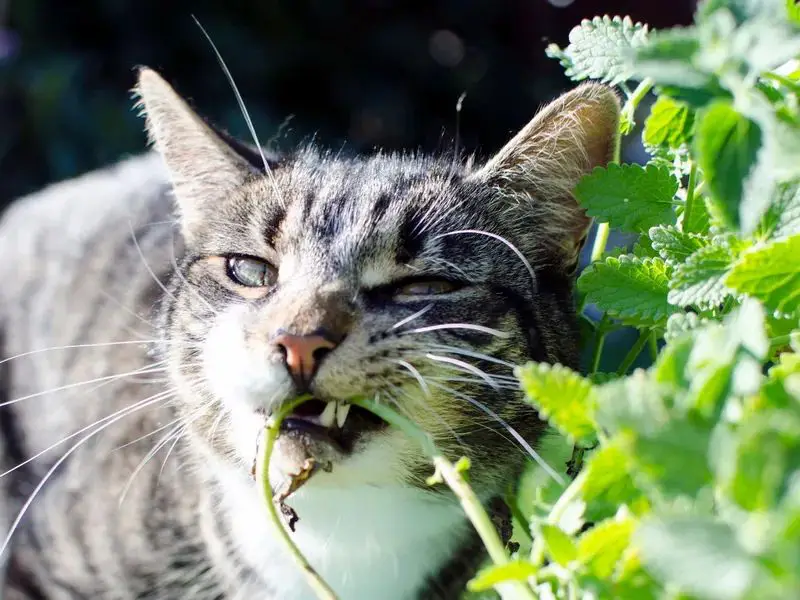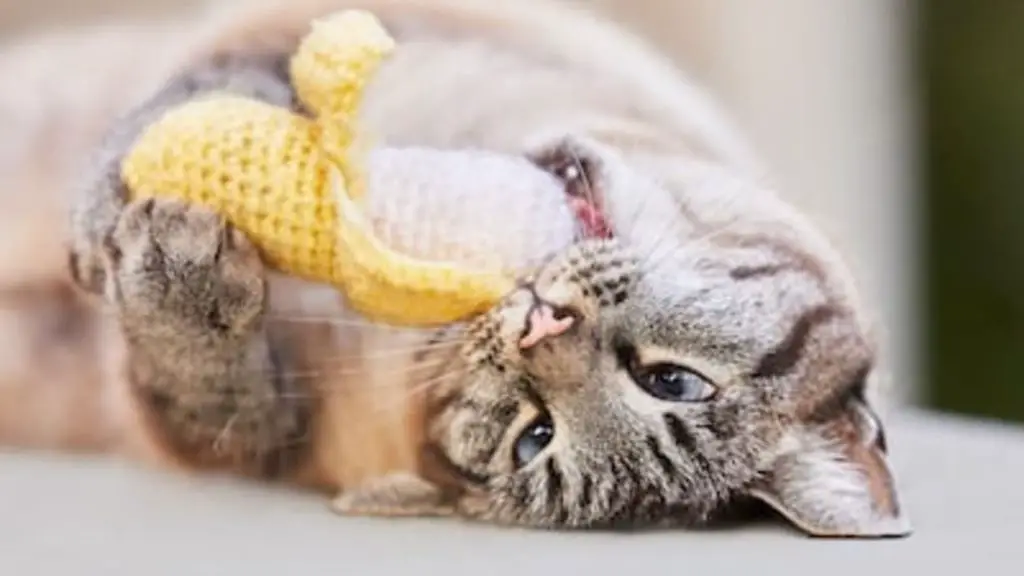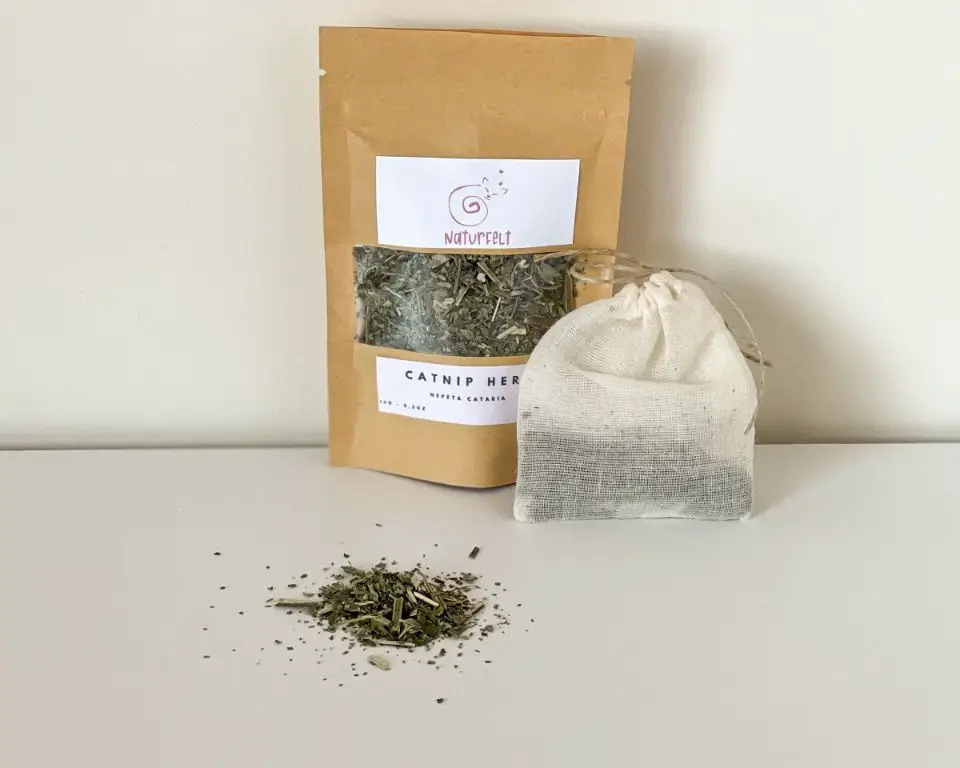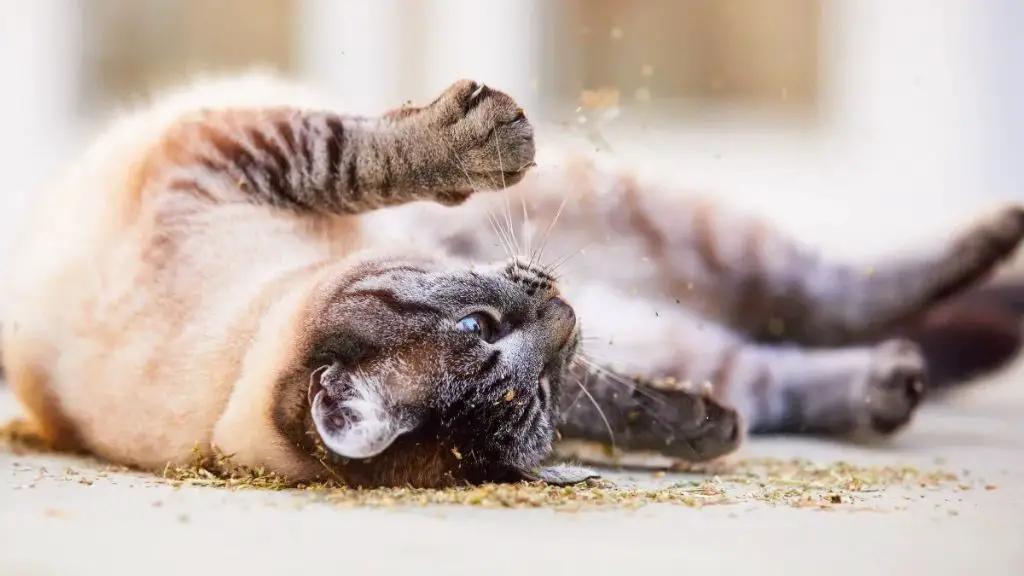What is Catnip?
Catnip is a perennial herb whose botanical name is Nepeta cataria. It is a member of the mint family of plants that also includes many other species like peppermint and spearmint.
Catnip is native to central and southern Europe, though it also grows wild in some temperate regions of Asia and Africa. The plant features small, white and lavender flowers and jagged, heart-shaped leaves that smell faintly of mint. Though catnip is often cultivated as a garden plant, it can also be found growing wild in fields, along roadsides, and other undisturbed places.
Active Chemicals in Catnip
The main active chemical in catnip that causes a response in cats is called nepetalactone. Nepetalactone is an organic compound that mimics feline pheromones and binds to olfactory receptors in a cat’s nose. Even very small amounts of nepetalactone can cause a response in cats.
Catnip contains about 0.3% to 1.4% essential oil by dry weight, and the main component of the essential oil is nepetalactone (70% to 80%). Other chemical compounds identified in catnip essential oil include citral, geraniol, citronellol, nerol, thymol, and carvacrol [1].
Nepetalactone is structurally similar to valepotriates which are chemicals produced in the plant valerian. This structural similarity is likely why both catnip and valerian induce sedative and stimulatory responses in cats [2].
Catnip Affects Felines, Not Humans
The psychoactive chemical in catnip that causes euphoric effects in cats is called nepetalactone. This organic compound doesn’t induce effects in humans the way it does in felines (1). While some people claim that drinking catnip tea produces mild sedative effects, there isn’t scientific evidence that nepetalactone is psychoactive or physiologically active in humans.

According to Healthline, catnip doesn’t provide a high for people like it can for cats (2). The sedative feeling some report from catnip tea is likely a placebo effect rather than a true drug response. Overall, researchers agree that catnip does not cause noticeable changes in human consciousness and the chemical that drives cats “crazy” does not impact the human nervous system (3).
Sources:
(1) https://www.webmd.com/vitamins/ai/ingredientmono-831/catnip
(2) https://www.healthline.com/health/smoking-catnip
(3) https://www.popsci.com/science/article/2013-04/catnip-effects-humans/
Catnip Response Varies
Not all cats respond to catnip in the same way. Studies show that only about 50-70% of domestic cats exhibit a response to catnip [1]. The response is due to a genetic trait, with cats that lack the gene being unaffected by catnip [2].
Furthermore, very young kittens do not respond to catnip. The catnip response typically emerges around 3-6 months of age, after which most susceptible cats will respond consistently throughout adulthood [3]. The reason for this age limitation is not fully understood, but it may relate to olfactory system or brain development.
In susceptible mature cats, about 20-30% may not respond to catnip every time it is presented [1]. This inconsistent response could be influenced by factors like the cat’s current mood or environment.
Additionally, the intensity of the reaction can vary between individual cats and circumstances. But overall, catnip induces a pleasurable experience in the majority of mature cats.
Catnip Can Cause Euphoria
Catnip contains an oil called nepetalactone that triggers a euphoric response in cats when inhaled or ingested (1). Nepetalactone binds to olfactory receptors in a cat’s nose, which sends signals to the amygdala region of the brain that controls emotions and behavior (2). This causes the amygdala to release dopamine, a feel-good neurotransmitter that creates a temporarysense of euphoria and relaxation similar to the effects of narcotics in humans (3).
The euphoric state induced by catnip will cause most cats to exhibit behaviors like cheek rubbing, licking, head shaking, rolling, and excited zooming around. They appear happy, content, and extremely playful (1). The euphoric effects of catnip only last about 10 minutes before neurons become overstimulated and the cat loses interest (2). After about two hours, the cat can experience the euphoric effects of catnip again (3). So catnip provides cats with a temporary “high” that makes them energetic, excitable and joyful.
Sources:
(1) https://academicworks.cuny.edu/cgi/viewcontent.cgi?article=1272&context=hc_sas_etds
(2) https://www.scientificamerican.com/article/experts-how-does-catnip-work-on-cats/

(3) https://www.ncbi.nlm.nih.gov/pmc/articles/PMC1480656/
The Catnip Response
The main way cats experience catnip is through smelling it. The active chemical compounds in catnip bind to receptors in a cat’s nose and mouth, which triggers a euphoric response [1]. Smelling catnip typically causes about 10 minutes of behavior such as sniffing, chewing, rolling, pawing, licking, and head shaking [2].
Eating catnip amplifies the euphoric effect more than just smelling it. After eating catnip, the response can last 5-15 minutes. Once the catnip wears off, cats won’t have another reaction to catnip for 1-2 hours, as they will have become temporarily immune to its effects [3].
Is Catnip Addictive?
Despite how much cats may enjoy catnip, it is not addictive in the same way that drugs can be addictive for humans. Catnip does not contain any addictive compounds like opioids that could lead to dependence and withdrawal.
Additionally, cats experience a refractory period after exposure to catnip, during which they are temporarily unable to experience the euphoric effects again. This refractory period lasts approximately 2 hours. As a result, cats cannot continuously use catnip to experience a euphoric high [1].
According to veterinary experts, cats cannot become addicted to catnip in the same way that humans become addicted to drugs. Regardless of the frequency or amount of exposure, cats will not go through opioid withdrawal or exhibit drug-seeking behaviors [2].
Potential Benefits of Catnip
Catnip contains active chemicals like nepetalactone that can provide various health benefits for cats when used appropriately.
One of the main benefits of catnip is as a natural stimulant and stress reliever. The nepetalactone in catnip can induce a temporary euphoric effect in cats that encourages playful behavior and activity. This can be a useful way to stimulate exercise, relieve boredom, and reduce stress or anxiety in cats.
Some research also suggests catnip may have an antidepressant effect in cats. One study found that cats exposed to catnip were in an upbeat mood afterward compared to cats exposed to a placebo[1]. The stimulation and mood-enhancing properties of catnip may help relieve symptoms of anxiety, depression, or chronic stress.
When used appropriately under supervision, catnip can be a safe way to provide mental stimulation, encourage playtime, and potentially benefit a cat’s overall mood and stress levels.
Potential Risks of Catnip
While catnip is generally considered safe for cats, there are some potential risks with overindulgence. According to the PetMD article[1], too much catnip can cause health problems in cats, such as vomiting, diarrhea, dizziness, or having trouble walking. Cats should only be given small amounts of catnip at a time.
The euphoric response catnip causes in cats can also lead to aggressive behavior if they become overstimulated. As noted in the WebMD article[2], catnip is considered possibly unsafe when consumed in very high doses. Overindulgence can cause cats to become overly excited or anxious.
Additionally, pregnant cats should avoid catnip, as it may stimulate uterine contractions. It’s best to refrain from giving catnip to pregnant cats until after the kittens are born.
With proper dosage and moderation, catnip is generally very safe for cats. But providing too much catnip or allowing overindulgence can cause adverse health effects. Monitoring your cat’s intake is important.
Using Catnip Safely
When used properly, catnip can be a fun and safe treat for cats. Here are some tips for using catnip safely:
Use sparingly as an occasional treat. Catnip should not be an everyday indulgence for cats. Limit catnip to once or twice a week at most so it remains a special experience for your cat.
Buy high quality organic catnip. Be sure to purchase catnip from a reputable source. Organic catnip has not been treated with pesticides or other chemicals that could be harmful if consumed.

Monitor your cat’s individual response. Pay attention to how your specific cat reacts to catnip. Limit use if your cat shows signs of anxiety or aggression instead of happiness. Every cat responds differently.
Store catnip securely. Make sure your catnip stash is sealed tightly and kept out of reach of pets when not in use. Ingesting large amounts can cause vomiting or diarrhea.
Never give catnip to kittens under 6 months old, and introduce slowly to older cats. Kittens and cats new to catnip should be closely supervised with their first exposure.
Avoid getting catnip on human skin. Catnip can cause skin irritation in humans. Wash hands after handling.

Watch for signs of excessive use. Limit catnip if your cat shows compulsive seeking behaviors or no longer reacts to standard amounts.

